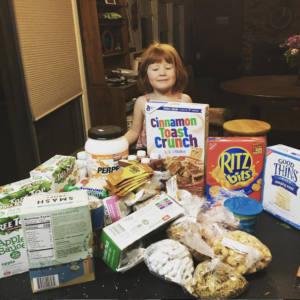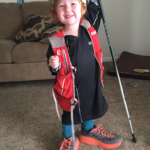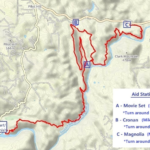Of 100 mile DNF’s and Food: A Reader Question
| November 11, 2019 | Posted by Melinda under Uncategorized |
I had a reader send me this message in part:
I was okay with the DNF (Mel’s note: this person attempted Rio and wasn’t able to make it to the finis line) for the first couple days but now I’m just upset and disappointed about the DNF. It has been really bothering me and making me so bitter that I decided to do a 20 mile run yesterday to just make me happy (Another Mel note: Lordy. I was just happy to do some mobilization and a walk around the block today). I know you talked about some of the food that worked or didn’t work but I’m curious about what food you actually carried with you and ate. I’m a rookie and just want to know what veteran 100 milers do.
Eating during an ultra is the hardest and most necessary thing so it deserves an entire blog post. There’s a saying in one of my favorite equine exercise physiology texts that the limit of a horse’s ability to do endurance distances is based on how well and for how long they can manage their electrolytes. For human ultra runners, at least the back of the pack ones like me, I think the entire event depends on being able to get calories into your body.
But first. Veteran 100 miler? Veteran? VETERAN? Umm…. not really. At this point I’ve DNF’ed as many 100’s as I’ve finished. I think about 100’s a lot, write about them a lot, research them endlessly, and train for them constantly. I definitely don’t have it figured out and every time I step up to the start line I have serious doubts on whether I belong there. I don’t want to claim any expertise other than my love for the trail, the distance, and a love for “going long” that has been insatiable for the last 20 years. So as long as you understand that we are all our own one rat study and I’m muddling through this same as you, let’s talk about food, right after we chat about DNF’s.
DNF’s (Did Not Finish, ie unfinished business) can be incredibly powerful. Every single one that I have on my record hurts and I can list them off far more easily than any of my *finishes.
*2014 50 mile DNF at mile 32 at the Pioneer Express because mentally I just didn’t want to run any more. 2018 Tahoe 100 mile at mile 60 something due to what the medic believed was a partial achilles tear. 2018 Rio 100 mile overtime DNF at mile 83.5 miles after making some pacing errors and being too confident in my ability to get myself to the finish line sans pacers.
Here’s the thing. Owning those failures and forcing myself to think about them and evaluate what led to them has resulting in problem solving and becoming a more resilient ultra runner.
That’s a good thing.
Because the only other thing that limits your ability to run 100 miles other than calories is your ability to problem solve.
Let’s do some problem solving.
Concept 1: You need 200-300 calories an hour
Solution: Set a timer on your watch every 30 minutes. If you get hungry before then, eat. If eating was the furthest thing from your mind when that timer went off (this was me for the entire 2019 Rio 100 mile race), eat anyways.
Sometimes I can eat the 100-150 calories immediately when the timer goes off. Slurp and done.
Sometimes I can manage about half of what I need, have to carry the rest in my hand for a couple minutes before being able to get the rest down.
Sometimes I can barely nibble on it for the next 30 minutes, but I nibble it over and over and over until it’s gone.
In races where my stomach is good (majority of them) I naturally get hungry about every 20 minutes. However, if my GI tract is off at all, or it’s a long race such as a 100 miler where you must run through the night and some of the morning the timer is essential because there’s just too much for your brain to keep track of. Near the end of a 100 miler just continuing to move my feet forward at a good pace takes 99 percent of my brain cells’ attention, never mind the other things I have to do to support that effort.
Concept 2: Use Aid Stations as Supplement Only
This was revolutionary for me when I first hear Stephanie Howe Violett say this in an interview. I’ve got to say, I’m all about the free food. Want me to come to a social function? Feed me. I consider the fact that they will feed me good enough reason to do 100 miles or really how ever many miles they want to mark for me. What do you mean I should pack my own food? In addition to being a food lover, I’m also lazy AND cheap. Why not just eat aid station food?
Because you need to eat every 30 minutes.
Well, you can just carry baggies of food away from the aid station right?
Because you can’t depend on what they have and if it will be right stuff. Because you will have less flexibility if you depend on what the aid station has when you need to problem solve your nutrition. .
But they list what they are going to have on their website/I know the RD/I ran it last year.
Look. We could all pretend that everything goes according to plan when you put on a race. Or when you run a race. But it doesn’t. It’s a really good idea to take personal responsibility for your race and make sure you do everything you can to make sure you are successful. Whether that’s carrying a map or GPS track of the course, filling your bottles at every aid because you never know what’s coming on the trail, or carrying your own food. Perhaps it’s the time spent at the back of the pack, but sometimes I get to aid stations and there’s no water. Or a very limited type of food. It doesn’t happen often, but it happens enough that I’m happy that I haven’t thrown myself totally at the mercy of the race.
But let’s not get too negative and doom and gloom. Most likely you are running a race where there’s enough food and water to go around, and even if they are out of ginger ale when you get there, there’s probably coke. But you still need to bring your own food.
I do eat aid station food, especially after night fall when they start cooking hot food. YUM! And, if something looks good on the table no matter what time it is, I’ll definitely eat it. There’s certain races where the volunteers bring homemade “specialities” (like beet ginger sushi!!!!) that just hit the spot. But, the point is I never count on it. I use the aid station to supplement what I have brought.
Concept 3: Organization
Nothing is less appetizing than something that has sat in my pack for a couple of hours. Solution: Whenever I have a drop bag I use an all-in-all-out strategy. If I haven’t eaten it by the time I’ve gotten to my next drop bag, it’s not something I’m going to eat later!
Most of the of foods I choose are not more than 200 calories. I’ve tried some bigger foods but 250-300 calories is just too much to eat, and trying to wrap up the last half of something to eat later just makes it look unappetizing. So, my rule is that single serving things have to be around 150 calories or less.
When I’m pre-race planning I put all my food out on my counter with small snack bags. Then, I calculate how many 30 minute periods are between drop bags. One snack per 30 minute block. Not all of my snacks are 100-150 calories (applesauce is only 45 calories per pouch) but it all averages out. The most important thing is to get calories trickling into the GI tract every 20-30 minutes and I’m carrying enough calories it works out.
Concept 4: Consider Palate Fatigue and Timing of Foods
It’s really easy to have too much of the same kinds of things. Solution: variety grab bags. I buy a variety of crackers, cookies, and treats and put a couple of pieces of each in a small ziplock. When a food alarm goes off there’s usually something in the ziplock that sounds good. Sometimes it’s the ritz bitz with cheese. Sometimes it’s the chocolate covered pretzels. Sometimes it’s these really delicious square honey sesame chip things. Mmmm…..because I have an all-in-all-out re-fuel at drop bags, the ziplocks get replaced each time with a new refreshed version. If I end up only feeling like eating sesame corn chips and skippy peanut butter balls, I can! A small handful of snacks from these baggies is usually in the right calorie range. Think of it as a trail mix…but without the nuts or dried fruit (or at least, expanded beyond that!)
The other thing to pay attention to in lead up races is what kind of foods sound good when – morning, afternoon, and overnight? I keep a list on my computer of foods I’ve tried and liked. It’s amazing how fast you will forget stuff between races.
The last thing to consider is your emergency pick me up foods. Which food can you eat no matter what? What food will perk you up in the middle of a bonk? What are your problem solving foods if you start to not feel well?
For me, my “no matter what” food is applesauce packets. So I make sure I at least a couple of packets in each drop bag, and tend to carry more later in the race in the afternoon and overnight when I know it’s harder to eat.
Mentos are my go-to food for a bonk. With a roll of mentos in my hand I can climb any mountain in front of me.
My problem solving food is candied ginger or ginger candies. Ginger really does work to settle my stomach and often a piece of that in the afternoon or overnight is all I need to get my GI tract back on track.
Concept: What kind of foods do I want to use?
Solution: Have some of each and be flexible. Most of my foods are based on real, solid foods because historically that works for me. Try lots of things out in training. I’m always on the look out for a new possible food that might work during runs when I’m grocery shopping. Pretty soon you will start to notice themes. Nuts are hard for me to eat during runs and don’t feel good in my stomach. Too heavy. Anything with a high level of fat doesn’t sit well. I like sweets, but not candy. If it’s sweet it has to have a good amount of salt to balance it. I need savory options, but since I don’t like nuts and chips it can be tricky. With some experimentation I have options, and it’s one reason I’m excited about the after dark cooked options at the aid stations (broth, grilled cheese, turkey sandwiches etc.).
What about high-tech sport food options? Try them and see. For me, unless it is in really specific circumstances my body likes “real” food (really, that concept is questionable when applied to some of the things on my list, but in general my body doesn’t care for gels, bars, chews, etc), but I do have some sports food options that I know will work in specific circumstances to prevent problems or help problem solve them.
Finally, we have come to what the reader probably wanted in the first place……
What foods work really well for me
…with some notes as needed. (this doesn’t include hot food I eat at aid stations. This is what I have in drop bags and either eat at aid stations or put in my vest)
- Applesauce
- Mentos
- Uncrustables, the miniature size (the originals are too big), strawberry is the best flavor
- Chocolate almond milk or chocolate milk (becoming more intolerant of milk), individually packaged.
- Cold brew coffee – I like High Brew brand, one of the sweet with dairy options. I normally like black coffee, but just can’t during an ultra.
- Snack baggie assortment (Winco bulk bins are your friend)
- Skippy’s peanut butter balls
- honey sesame crisps
- Corn sesame chips
- chocolate covered pretzels
- Circus animal cookies
- teddy grahams
- Ritz bits with cheese
- Good thins (the rice ones, just plain)
- Caramel corn (has to not be too sweet, not gummy, stay crisp. Only winco caramel corn has so far passed the test)
- cinnamon toast cereal (remember, just eat like a toddler)
- Honey stinger waffles, caramel flavor ONLY
- Hammer’s perpectuem drink mix and solids
- Candied Ginger
Other stuff that I’ve tried and worked OK but not great, or I want to try.
- Moonpies. The problem was they were too big. I might like them if I can find the miniature ones.
- Turkey jerky from trader joes. I tried my friend’s on a training run and it was so good and hit the spot.
- Occasionally the sport gummies like Clif blocks taste really good.
- Welsh’s Fruit snacks are hit and miss. They turn my stomach pretty fast if I eat more than a few packets on a run. The other brands all stick in my teeth badly and require too much chewing.
- Really want to try other breakfast cereals because even on a sub-standard stomach that cinnamon toast crunch WAS THE BOMB.
- Kids cliff bars (oatmeal raisin flavor) work really well in training but not on race day.
- Kids power snap bars are decent and usually edible but not my absolute favorite.
- Those thin wafer waffle cookies with sweet cream in the middle, in a nut-chocolate flavor (so it has some salt). Good, but hard to find the right ones, and my stomach can feel over sugared quickly.
- Rice crispie treats – meh to bad.
- Local taqueria burrito. OMG THIS WAS SO GOOD.
- This beet ginger sushi that one of the local volunteer at races does. I haven’t tried making it on my own.
- Fresh fruit (what I take mostly from aid station stables).
- Small squares of lunch meat sandwiches on white bread. Delicious when I can find on an aid station table.
There you have it! 2400+ words that can be summed up as: run 100’s, eat like a toddler. Bon Appetit!














Just finished crewing for a friend at the endurance Nationals in Ridgecrest. From reading your posts, I knew that eating was so important, so I dedicated myself to feeding my rider at every vet check (and other places where the trail crossed the road!). Had her sit while we took care of the horse and filled pack and water bottles and every time her hand was empty, I put food or drink in it. She was calling me Mom by the end, but she did finish!
Yay! do you think it made a difference in how she felt? I have such a hard time eating at endurance rides because of nerves. :/
She’s a young woman, very tough and used to going fast, so nerves not a problem! I think she did end up feeling pretty good. She went slowly, so was a long time in the saddle (which she isn’t as used to as I am!). A little sore (but not hungry!) by the end and bright-eyed and bushy-tailed by awards time (and I made sure she ate breakfast there too).
You are an awesome crew. Good job! I’m totally cracking up at “a little sore (but not hungry)” ??